Belgium battlefields Day 3: Ypres to Dunkirk – 62 miles
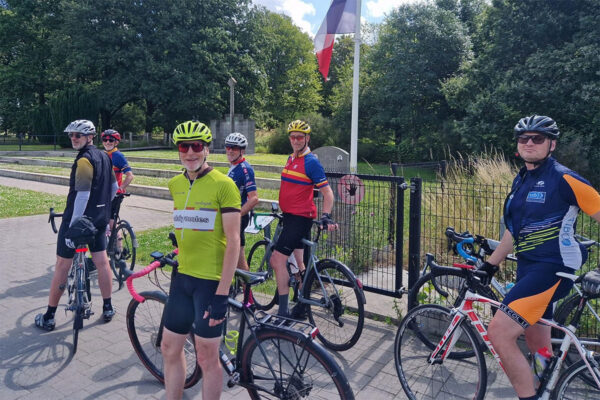
Our last day unexpectedly turned out to be the hardest day I’ve had on a bike.
Actually, it was more like my hardest half-day as the morning riding felt rather joyful. It had its sting – a climb up the Kemmelberg for one, as well as visits for German and Allied trenches. But the cycling? Perfecto!
This was partly because we arranged to leave our bags and panniers at the Hotel Albion before heading out, in the knowledge we would be looping back to Ypres for lunch before heading back to the coast.
After the thin gruel we had the day before, today’s breakfast was a hearty affair. We ate in the hotel and a decent spread was available for us, looking out onto a sunny courtyard that promised a fair day ahead.
Back on our bikes, unencumbered by weighty panniers and bags, we turned south out of the Menin Gate. I hadn’t quite realised the ancient nature of Ypres. Yes, the town square was quaint, but we soon skirted the town by tracing our way along a cycle path by the wide moat that surrounds the central area. In the sunshine it was a pretty route and I’d like to come back and explore further.
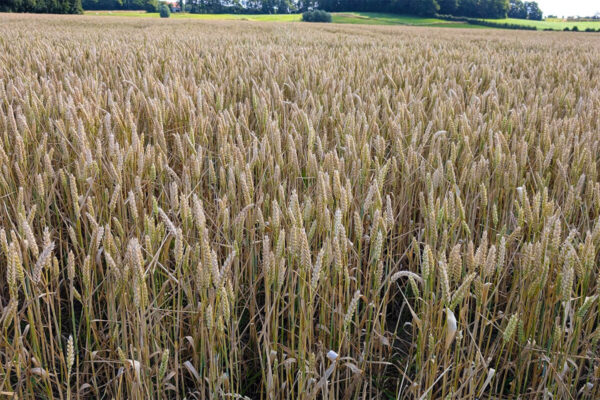
Up (and down) the Kemmelberg
In fact, the suburbs – such as they are – don’t extend terribly far. Very quickly we left the town behind, passing the American cemetery (another place needing a visit). A well kept, well frequented cycle lane brought us to the village of Kemmel within about 5 miles and the start of the Kemmelberg climb.
The Kemmelberg is quite famous, appearing regularly in the Spring Classics as part of the Gent-Wevelgem race. In fact, a colleague of mine once raced the junior Gent-Wevelgem, going over the top of the ‘berg in the leading group and riding it in both directions. Fair play to him!
The town was preparing for a race when we were there (the Kemmel Koerse), with lots of food stalls set up in the town square and a finish line being constructed for later in the day. We set of as a disparate group in ones and twos to tackle the highest point in West Flanders.
I would compare it to Box Hill but that’s not quite fair. It is shorter but steeper and of course the meat of the climb is paved with the notorious Flemish pave, big cobbles that suited my 42c gravel tyres much better than Lloyd’s 25c skinnies. Even so, he made relatively light work of the climb.
The big controversy was MarkC pipping me to the finish line on the marked Strava segment. I could graciously describe it as a real poachers win but really I was blatantly robbed (while fully expecting the climb to turn a bend and kick on; it didn’t!)
So, at racing speed I can imagine it’s brutal but it remains quite rideable for us mortals.
Heading back down, again, 42c tyres for the win. In the dry they felt fantastic and I was revelling in my pannier-less Topstone feeling quite sprightly. In the wet, in a race, in March, on skinny tyres? A different story for sure.
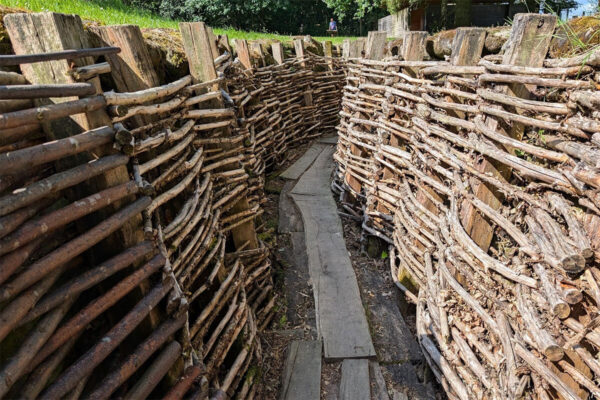
Bayernwald German trenches
Before leaving Kemmel we bought entrance tickets from the tourist office for the German Bayernwald trenches. They are preserved remnants of a much larger defensive line and are just 4 miles cycling from Kemmel. It was a surreal experience riding across ‘Flanders Fields’ in perfect weather, trying to imagine it reduced to a hellscape of mud 100 years ago.
The trenches have displays and information to help visitors make sense of what they are seeing. It’s humbling to see visitors and families of various nationalities but particularly Germans exploring what is today a peaceful wood.
The German trenches were lined with hazel and appeared to be carefully constructed, the intention being defensive to hold the high ground they were on. But – as with the Allied trenches later – they weren’t very deep. You clearly could make safe progress through them without risking sniper fire unless you moved at a crouch.
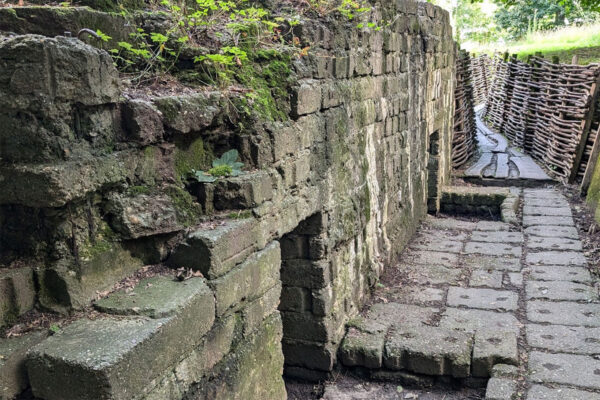
It was a sobering experience. Just 100 yards away down the hill would have been the Allied forces in their own trenches, staring up at the rise for four years, knowing it was a hill they were unlikely to climb without radical intervention.
That intervention came in the form of 19 immense mines dug under German treches along the line over the course of a year and packed full of explosive. A surprise attack blew everything (and everyone) sky high but did little to significantly break the stalemate.
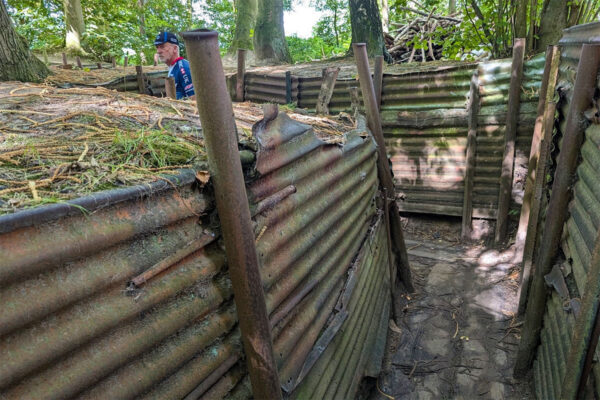
Sanctuary Wood (Hill 62) Allied trenches
The Allied trenches at Sanctuary Wood, five miles to the east of Bayernwald illustrated the scene from the Allied perspective.
To be honest, the trenches – compared to the Germans – were awful. They were poorly made, with none of the hazel lining of the German trenches. The Allied design – as such – was clearly considered to be a transitory arrangement before we would push on to Victory over the enemy forces.
History just didn’t turn out like that; the trenches had clearly suffered direct attack, with sheets of corrugated iron over parts of the trenches to protect from shrapnel and debris and visible shell holes close by. What a stupyfying thing to have experienced at the time.
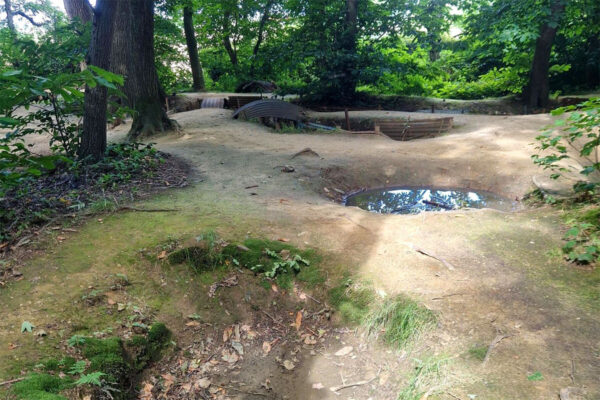
Close by was the Hill 62 memorial and Sanctuary Wood cemetery but we just didn’t have time to stop and investigate. As I have mentioned previously, this is a topic you could spend multiple days exploring. For instance, we passed the Hill 60 memorial on our way to Sanctuary Wood, but also couldn’t stop.
The idea of the trip was to get an overview of events and I think we achieved that.
A sunny lunch
Back on the bikes once again, it was also back to Ypres for lunch. A brisk paceline formed and we didn’t take long to get back to the city, completing a morning loop of 20-21 miles.
Lunch was on the market square where we sat in the sun and enjoyed a final meal before heading home. I was feeling good and found the morning’s riding to be easy and the sight seeing interesting.
What I hadn’t really registered was how much of it had been spent in the sunshine. In fact, over the meal I sat in the sunshine too. Before we loading up our bikes for the return home I applied sunscreen in anticipation of a few more hours riding. With 40 miles to go and a gentle post prandial pace it would take 3 hours at least.
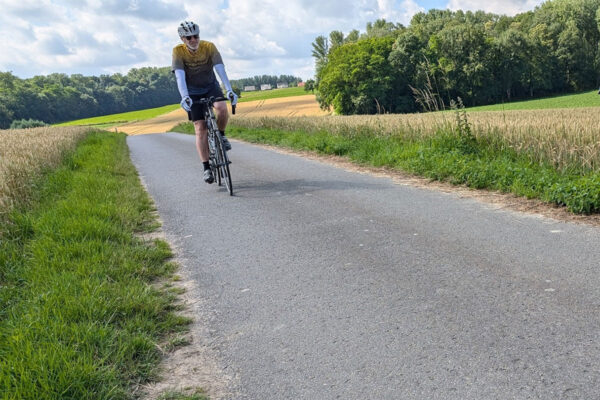
At my age, never trust a…
Heading west out of Ypres, guess what?
Correct!
Headwinds, in our face and straight out of west. The meant we could look forward to a headwind or a crosswind for most of the next few hours.
The route was also exposed to the sun but I didn’t particularly think about that, especially having applied my sunscreen. Unfortunately, after about five miles I started to feel ‘not right’.
No headache this time, just a creeping sense of ‘where’s my mojo gone?’.
Stopping for a pee, I realised with horror that I couldn’t afford to relax anything at that point! I’m not talking the full Greg LeMond experience here but the ‘not right’ feeling was quickly turning to ‘uh oh!’.
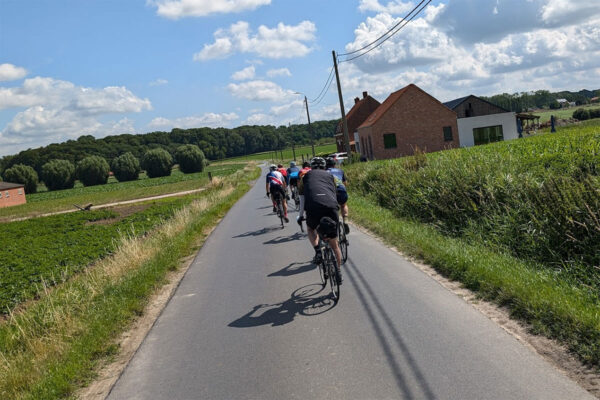
Gruelling
The next 35 miles miles were hellish. Not only could I not afford any kind of gastro-intestinal relaxation but for the same reason I couldn’t afford to drink anything either. There was no way I could let it out without playing a high stakes game.
So I tucked in at the back of the group to shelter as much as possible from the wind, nursing painful guts and getting more and more dehydrated as the miles clicked up. My expectations from my morning ride had been the return leg would be a comfortable cruise. The reality was absolute misery.
Equally hard to ignore was a large spreading area of sunburn down my left calf and around my knee which was starting to feel tight. In fact, for days after it looked like a purple bruise and has only just settled.
Woah! not feeling great
The journey back from Ypres is straightforward; we should have ticked it off very easily. After three days of riding, and three days of headwinds our tired legs decided otherwise. At some point about 5 miles out it was determined we could make the earlier ferry crossing.
This was quite reasonable but I wasn’t the only rider with issues. Still we pressed on – I was hurting but at the same time the ferry would offer its own sanctuary in the form of a toilet cubicle!
Our eagerness to minimise the distance nearly brought disaster as we neared the terminal as we suddenly found ourselves on heavily trafficed roads without a cycle lane in sight. This was not the point for MarkC and JR to chase the last King of the Mountains points of the weekend with a large artic bearing down on them. The rest of us watched on, flinching.
By the time we were stopped for passport control, I was in a bad way. Shivering while everyone else seemed perfectly comfortable, I could barely stand up or turn the pdeals and had no awareness of anything around me. Catching that early ferry was a god send and lets just say there’s possibly a new alien life form left in the ship’s bilges.
Despite easing my stomach (and easing my mind) I still didn’t feel any better. In fact I felt awful and needed half the journey, a couple of large teas, a bottle of water and an ice cream proffered by my generous riding buddies before I started to feel sensible again.
Sensible enough to ride back to the car at least. I was very grateful Mark was driving home and not me, although with roadworks the journey was interminable.
A look back at our three day Belgium battlefield journey
Looking back at my last three days or reports you could be forgiven for thinking I had a terrible time on our cycling tour of the Belgium battlefields. But that’s not true at all.
Yes, my headache on Day 2 threatened to scupper the whole weekend for me and left me struggling to see straight. But it did lift and the late afternoon and evening were great. And yes, my ride back to Dunkirk was seriously traumatic before becoming quite debilitating. But I still managed to cycle back to the car once back in Dover.
Fortunately it was also just me that suffered problems and I think there is stuff to reflect on for the future.
An exceedingly good company of riders with an inquisitive interest in the world around them and the WW1 sites we visited really helped to make the trip a positive experience.
I think I would benefit from a room to myself to ‘recharge’ but Mark was a great room-y and I have no criticism there. Both hotels were comfortable and convenient places to stay and in fact I could easily have stayed another day in Ypres to enjoy hotel, the town and the battlefields further.
Another great plus is cycling in Belgium.
It’s so much more relaxing than riding our UK roads and a great way to see the countryside. We were unlucky with the headwinds (which always limit conversation), but Bruges and Ypres are both lovely towns with so much more to see than we could fit into our short break. Bruges in particular is a great place to visit with a spouse.
I’m also quite keen to go back; partly I wasn’t expecting to find WW1 history so interesting, partly because the riding aspect of the trip should have been much less fraught. 200 miles in three days is not excessive.
Of course, another thing to consider might be something WW2 focussed along the Normandy coast. Have gravel bike, will travel…
Every cyclist loves coffee!
☕Buy Matt a coffeeBe the first to reply
We really appreciate comments from our readers. If you have something to say, we'd love to hear from you.

()